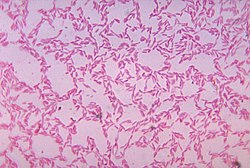Salinibacter ruber is an extremely halophilic red bacterium, first found in Spain in 2002. Salinibacter ruber is most closely related to the genus Rhodothermus...
7 KB (759 words) - 08:59, 9 March 2025
bacterial order Halanaerobiales, and the extremely halophilic bacterium Salinibacter ruber. The presence of this adaptation in three distinct evolutionary lineages...
22 KB (2,669 words) - 13:04, 7 April 2025
In some of the hundreds of Australian pink lakes, a red bacterium, Salinibacter ruber, may be involved in producing their colour. Work done by molecular...
13 KB (1,382 words) - 12:07, 25 April 2025
Geographic describes the colour as result of a pigment produced by the Salinibacter ruber bacteria. A rest-stop overlooks the lake's basin. Salt has been harvested...
4 KB (298 words) - 13:11, 18 February 2025
a metagenomic analysis on the lake to find Dunaliella as well as Salinibacter ruber, Dechloromonas aromatica, and a few species of the Archaea. In recent...
11 KB (1,208 words) - 05:09, 15 April 2025
Bacteroidota genomes except Salinibacter ruber. The absence of these proteins may be due to selective gene loss, or because S. ruber branches very deeply, the...
22 KB (1,887 words) - 11:08, 25 March 2025
Hillier in Western Australia have shown that other bacteria, notably Salinibacter ruber, along with algal and other factors, cause the pink color of these...
27 KB (2,688 words) - 19:16, 12 January 2025
archaeal family Halobacteriaceae and the extremely halophilic bacterium Salinibacter ruber both can live in high salt environment. Jellyfish-form hydrozoans...
138 KB (14,952 words) - 18:10, 3 May 2025
PMC 193775. PMID 12949112. Mongodin EF, et al. (2005). "The genome of Salinibacter ruber: convergence and gene exchange among hyperhalophilic bacteria and...
184 KB (8,892 words) - 09:13, 13 March 2025






